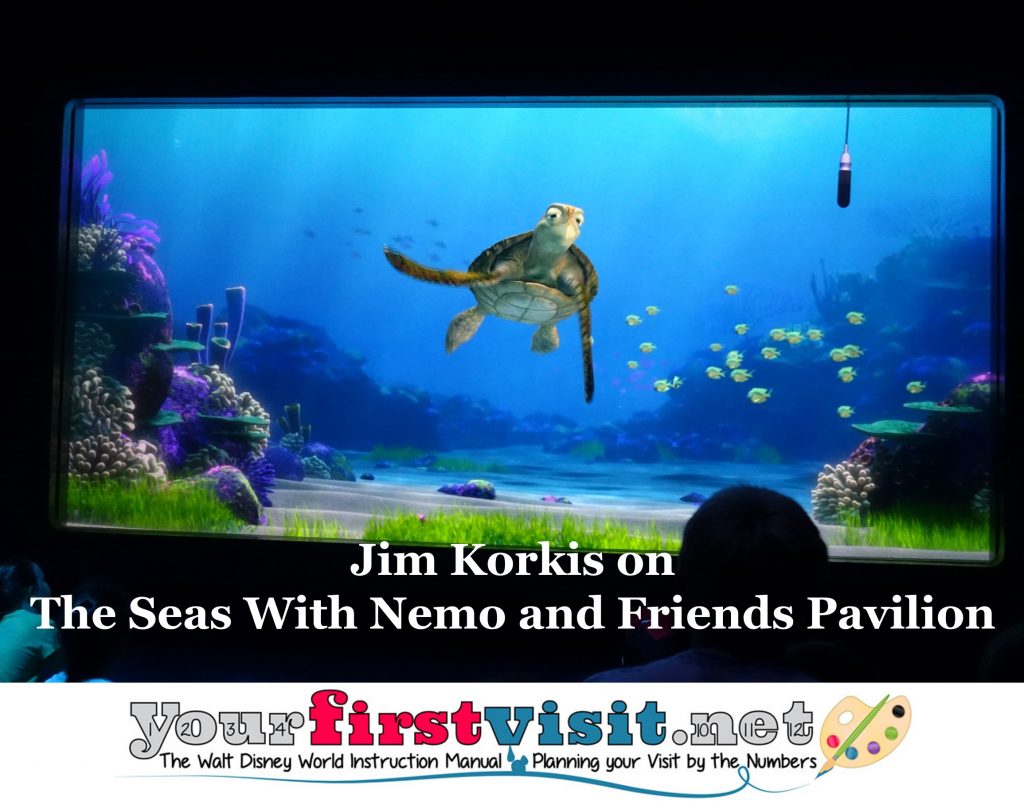
Welcome back to Fridays with Jim Korkis! Jim, the dean of Disney historians, writes about Walt Disney World history every Friday on yourfirstvisit.net.
THE SEAS WITH NEMO AND FRIENDS AT EPCOT
By Jim Korkis
The Seas with Nemo and Friends pavilion originally opened at Epcot in 1986 as the Living Seas Pavilion. The original version took guests to the depths of the ocean via “hydrolators,” to an underwater research facility known as SeaBase Alpha. Up until November 2005, the pavilion featured the world’s largest saltwater tank when it was surpassed by the Georgia Aquarium in Atlanta.
Between December 2003 and the rededication in January 2007, the pavilion began to transform to the Seas with Nemo and Friends inspired by Disney•Pixar’s Finding Nemo (2003). It became the first Epcot pavilion to be based on a Disney animated movie property, as the Imagineers added Turtle Talk with Crush, replaced the original seacab omnimover ride with an updated Finding Nemo experience now utilizing clamshell vehicles, and replaced the hydrolators and pre-show with an expanded queue and ride experience.
The catalyst for envisioning a whole new attraction was top-secret technology developed by Walt Disney Imagineering Research and Development that enables the Nemo characters to swim alongside live fish in the immense salt water aquarium.
The projection technology was developed by research and development designer Alfredo Ayala.
“Alfredo played with it, developed it, and set up a demonstration,” said executive show producer and vice president Kathy Mangum. “That demonstration really opened up the opportunity for us to create the finale. The technology really drove what the creative application could be.”
Roger Gould, creative director of Pixar’s Theme Parks group, directed the new animation. “Making the film, we fell in love with Nemo, Dory, Marlin, Crush and the rest of the characters, so it was so much fun to bring them back to life in a way that allows our guests to be part of the adventure.”
“We built projection surfaces into the dimensional sets and rock work in the undersea environments that are seamless,” explained senior concept writer Kevin Rafferty, “so the magic of it is you see the characters you love from the film in this dimensional, underwater environment. There are times where it really seems as if the animated fish and the actual fish are interacting and sharing the same world. When that happens, it’s really glorious.”
The animation of Nemo and his aquatic pals was created by many of the same Pixar artists who animated Finding Nemo. Most guests miss some of the extreme attention to detail such as the moment Nemo swims out of a rusty pipe on the sunken submarine and little flakes of rust float out as well.
The undersea trek is enlivened by music orchestrated under the supervision of Thomas Newman, who composed the music for the film.
Robin Cooper, one of Pixar’s art directors on Finding Nemo, collaborated closely with the Imagineers to recreate the specific design of the coral reef from the film. “I started out in theater set design, so building the virtual world of the movie as physical sets was a thrilling experience for me. The Imagineers are artists and problem solvers, and every detail I described, they found ways to bring to life.”
“The technique allowed us to recreate the beautiful undersea world that was designed by Pixar for the film,” said Magnum. “What’s so important about this attraction is that it revitalizes the whole pavilion for us. Epcot is about exploring new places, and it was a natural fit to tell the story by using these characters.”
* * * * *
Thanks, Jim! And come back next Friday for more from Jim Korkis!
In the meantime, check out his books, including his latest, Off to Never Land: 70 Years of Disney’s Peter Pan and Final Secret Stories of Walt Disney World!
Follow yourfirstvisit.net on Facebook or Twitter or Pinterest!!
